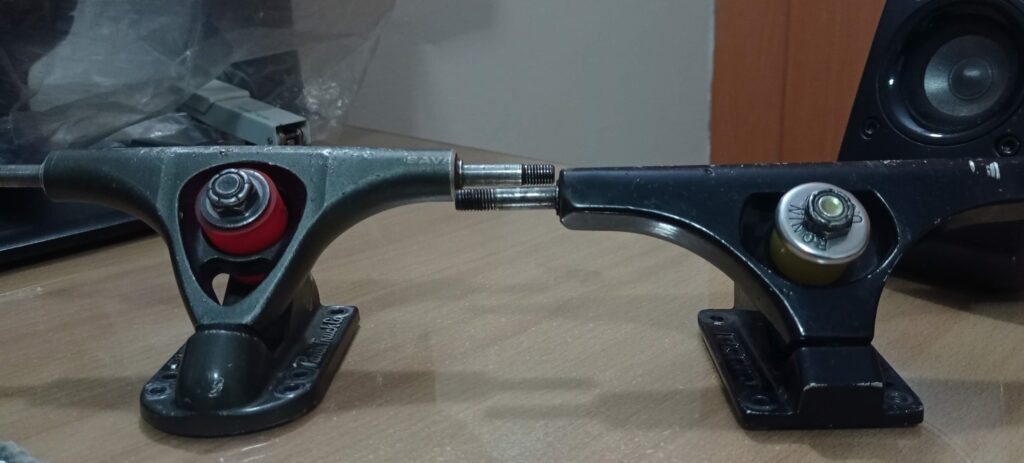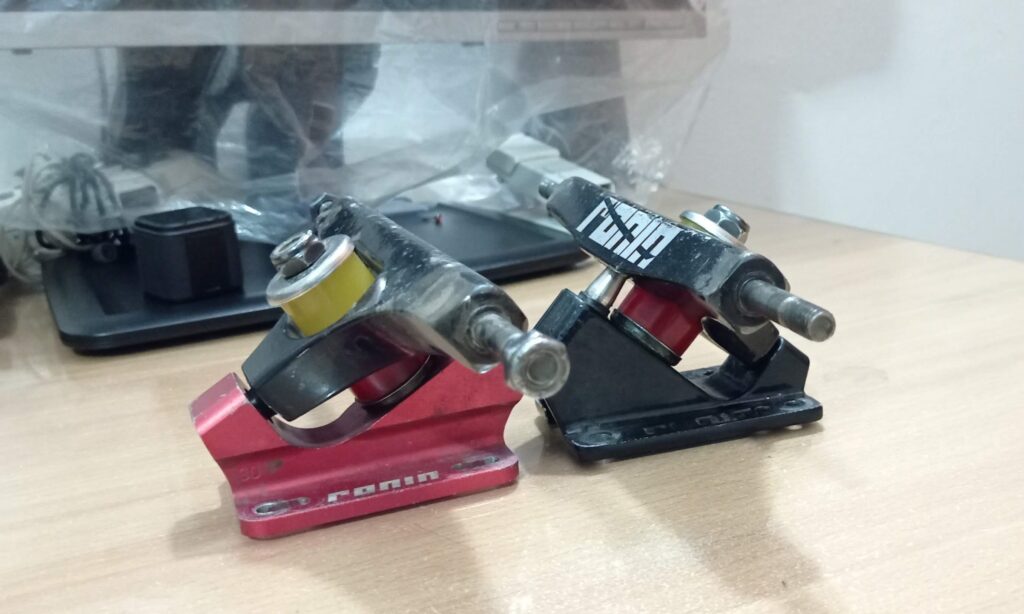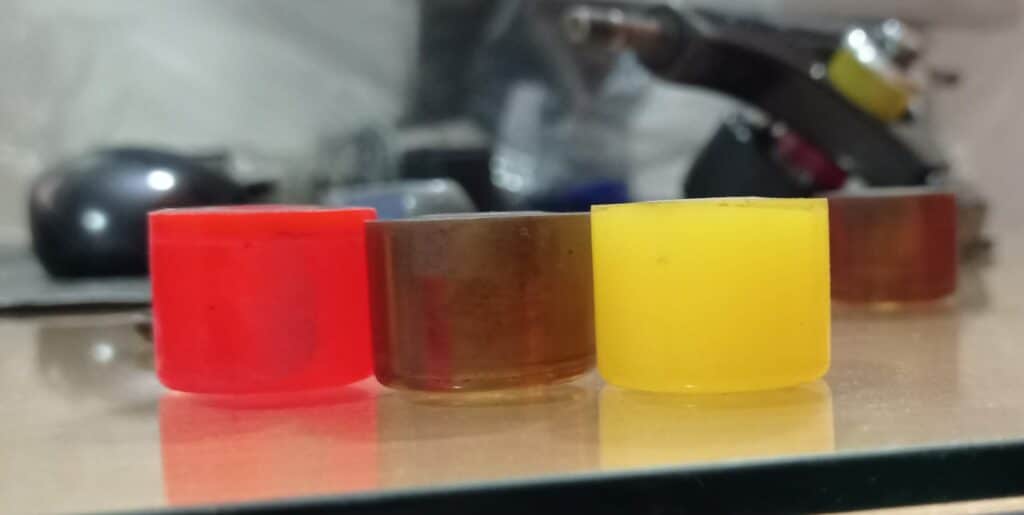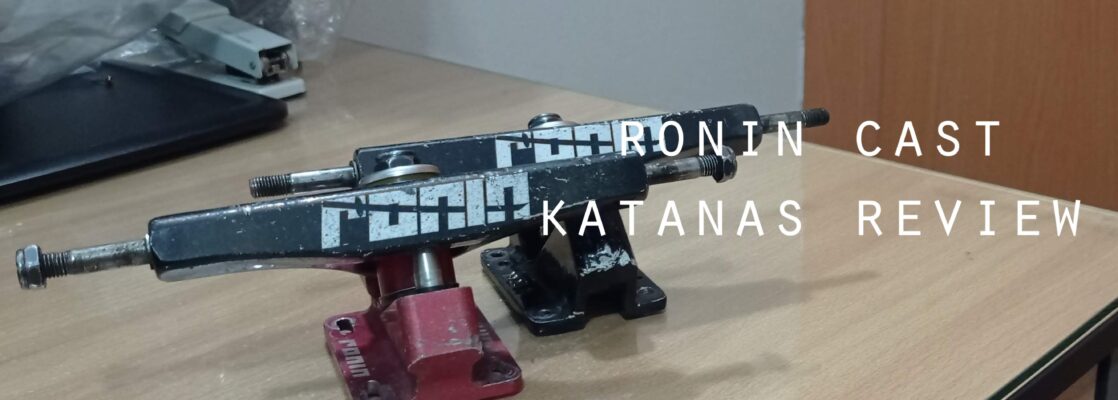Ronin cast Katanas are some of the best cast longboard trucks on the market – some riders even say they perform as well as some precision trucks … But how true is this? I’ve thoroughly enjoyed my time on my set and I’m stoked to bring this review to you.
Check out my review below to find out more about them. I’ve also included some tips to help you figure out how to use em.
Specs:
- Hanger width – 160mm
- Baseplate angles – 42.5/42.5 (I also used a 30* precision Billet plate)
- Bushing size – Tall
- Slop stopping system – Floating queen pin
- Construction – Cast
- Ride height – (shorted than Paris)
- Rake – 2.5mm
Setup
Freeride
- Deck – Rolling Tree Acedia/Landyachtz Cheesegrater
- Truck setup – 42.5/42.5
- Bushings – 88/92
- Wheels – Various
Downhill
- Deck – Rolling Tree Acedia
- Truck setup – 42.5/42.5
- Bushings – 88/88, 95/92
- Wheels – Various, mostly Sesmic Alphas
Ronin Cast Katanas Review
Admittedly, I’ve always idolized Ronin trucks – particularly because they have an amazing team of riders who do really well to show what this truck is capable of. You’ll often find them (and most of their team) featuring on most race podiums across the world. Thiago Lessa used his set of Ronins to win the 2017/2018 IDF race seasons. So yeah, they’re often people’s first choice for racing.
Finally, they have a reputation for being dummy stable and a really solid choice for going very fast.
So yeah, it’s not hard to see why I was so hyped to get these under my board.
The CKatanas are super low in height
The first thing I noticed was how low these trucks were. They were much lower than 43* Paris, and maybe even lower (or just as low as) than Caliber trucks. I, unfortunately, didn’t have the tools to help me measure their height accurately.
I was super surprised by this, and it started to make sense why a lot of Ronin riders choose to skate them with risers.

Naturally, the first thing that comes to mind is wheelbite. Though wheelbite isn’t usually an issue for me – I’ve never gotten it when actually riding these trucks (even at low speeds), it is very easy to get when standing stationary on the board.
The trucks have a ton of lean, and that doesn’t help with the bite either. I would say it might be a good idea to throw some risers on there if you’re worried about bite. But personally, its never affected me. And as I talk about below, because they turn so much already, you never lean far enough to actually get bite when riding.
These trucks turn for days but have a strong centre
For freeriding, I had these setup on the 92a Fruit punch bushings all-around (and even went softer to 88/92a later). This allowed the trucks to turn on a dime, and to change direction very quickly.
Though they were turny, the trucks wouldn’t turn, or rather, that that turning wouldn’t be accessible unless I actively engaged the trucks by applying pressure either direction – not that they were hard to turn, but that they wouldn’t turn unless I was deliberate about it. (You could also say, they wouldn’t turn unless I wanted them to).
A bit of a long winded explanation yes, but this is just to illustrate how much of a “strong” centre these trucks have.
If I wasn’t DELIBERATELY applying pressure, they would keep going straight for the most part. And when I would apply pressure, the trucks would turn on a dime, turning a lot and having a really smooth lean – emphasis on the smooth.
Now I’m not saying they wouldn’t turn at all at that centre point, but rather, that the little turning/leaning they did wouldn’t be very significant …
The strong centre makes them stable
So this strong centre is what makes these trucks so stable. it’s what keeps them going straight and in a consistent sort of direction. So even if you use softer bushings, you’re still going to be locked in to that centre when you’re going in a straight line. Ofcourse, UNTIL you DECIDE to turn and really engage the bushings.
This isn’t to say you can’t get wobbles or twitch with these trucks. You can – they’re just longboard trucks at the end of the day. The difference is that you’re not fighting your trucks as much to keep them in a straight line. Some of the “responsibility” to keep them going straight is taken off you and done by the trucks.
And because of this, I was able to run symm trucks and not really feel stressed out about stability – even with them being turny as hell.
Do they feel “robotic”?
And if you’ve followed what I’ve said above, we can kinda see why people would call them robot trucks. They can feel like they take a lot of the fun, skill and challenge out of skating …
But after skating them for a while, I feel like they don’t REALLY feel like robotic cheat code trucks. They did make one or two things easier, but I still had to skate them well and make them do what I wanted them to. I still had to do a significant portion of the work to skate well.
In fact, I can relate my transition to these from the Savants, with my transition to the Savants from riding cast Calibers.
The Savants felt instantly smoother, more stable, and less twitchy. But at the end of the day, they were still limited by my input and application. They would punish me if I wasn’t careful and got sloppy.
So yeah, I didn’t find them to be as “mechanical” as most people complain, but …
So yeah, they largely felt like normal trucks and I didn’t really feel like the trucks were doing all (an exaggeration) of the work for me … I still had to be relaxed going fast, I still had to set up appropriately for corners, place my weight in the right places at the right time etc ..
And, as they did make one or two things easier, they opened up new avenues of what I could do on my skateboard. Because I could take different lines more comfortably, or tuck lean some corners I couldn’t before, they introduced some new challenges for me and new things to try out.
So, the biggest difference for me was that they ultimately changed how I interacted with the road … I could get similar performance from my other trucks if I set them up appropriately.
So I wouldn’t say they are cheat code trucks, but rather another flavour that some may enjoy given various circumstances.
But I will say, they made skating feel a bit easier.
The turning and steering had a very ‘direct feel’
I think this is mostly thanks to the smooth cylindrical pivot. The turning is really “direct” and responds exactly to your input.
They turn into the slide, as opposed to breaking into it
A big thing I found with these, is how they broke into the slide. They didn’t really get to an edge of lean where you then pushed them into the slide. Rather, they oversteered/turned into the slide as you applied the pressure to push them out of traction. A bit different from other trucks I was used to.
To be honest, this is a rather small difference – and it might be insignificant for some. You can certainly skate them however you want. But for me, understanding and applying this really helped me feel like I was making the most out of them.
But yeah this characteristic for me made the difference when I was doing freeride and stand up slides. I felt like I had to setup carve less and focus on loading up the wheels to push them out – as opposed to doing a big setup carve as usual. I also felt like I didn’t have to kick out the back as much. A light push was a bit more effective otherwise I would ice out – I talk more about this below.
The lean is deep and satisfying
I really liked the lean on these trucks, and it made a difference for me when I was going through some corners. I just felt like that extra lean from the bushings and that open bushing seat allowed me to lean deeper in the corners and get better lines. I felt like I had a tiny bit more turning available than I did on my Savants and on some other cast trucks I’ve tried.
This “extra turn” feeling was really surprising given the trucks baseplate angle is 42.5*. They felt almost as turny as a 50* Paris truck.
I also felt like there was a tiny bit more lean available. With a truck like the Savant, I always feel like I get to that edge of lean very quickly and I always feel limited with what I can do once I lock into a line to go through a corner.
But with these, they felt like there was always that bit more of lean available and that I could use it at any time – even in the corner to turn a bit deeper and take a better line!
I felt myself taking new lines and being able to make the most of my body positioning and weight application. It was a refreshing feeling.
Finally, the lean felt very smooth, controllable, and almost “linear” feeling. In a sense, the truck didn’t suddenly dive (too much) or flop over, but it leaned over in a consistent manner and I felt like I was really in control.
Super smooth slides
My Seismic Alphas usually chatter with heelside slides when I have them on my 140mm Savants (video below as reference), they did not chatter at all on these trucks.
I’m not entirely sure why perhaps the queen-pin allows for better weight distribution across the wheels and because they’re so low to the ground pushing into them was easier? Not sure. But most wheels slide smoothly on these, even thick boi DH wheels.
It definitely felt like I could apply and use the full contact patch of the wheels … Ofcourse this is all based off feeling, so it might be a bit inaccurate.
They have comparable performance to forged trucks (and maybe even some precisions)
These trucks worked really well and I didn’t feel like they lacked anything – rather there wasn’t a glaring hole in their performance (which a lot of trucks have). They definitely felt like a big upgrade from normal cast trucks and even performed better in some situations than some forged trucks. In fact, some other riders say they feel better than some of the precisions on the market …
My biggest motivator to upgrade to a precision or a forged truck is when I feel a truck is limiting my performance as a rider, or if I feel like there’s nothing more that truck can give me and it’s affecting my riding experience …
I’ve been skating these for a while and I still feel like I haven’t fully made the most out of them. Even with the Paris Savants, as great as they are, I felt some limitations within a few months of riding them. I feel like the cKatanas have more to give me and that they are more versatile in terms of performance than the Savants. I wouldn’t be in a rush to upgrade them.
**That said, your mileage might vary on this. But definitely, these trucks have that performance on lock.
So in terms of performance, these are worth it. They outperform other trucks in that sort of price range, even if they do have lower quality construction … more on this below.
Some thing dope – the Ronin Cast Katanas are compatible with every other Ronin hanger, baseplate etc. ..
These trucks have the exact same geometry and pivot size as the precision Ronins. This allows you to interchange them so you can use a precision plate with a cast hanger, or vice versa. This is really nice as you have a pathway to upgrade your trucks towards being full precisions. Or also nice because you have the options of getting different baseplates for more stability, more turning, different feel etc.

I personally used a 30* plate and I really enjoyed that for stability and a more locked in feel in the back . If you’re lucky enough, you can get a 25* plate, chop your trucks down, and you’ll have some budget smol, fast DH trucks.
Do they suck for freeride?
I would say no. I had a ton of fun on these and I was able to do a lot of fast freeride.
I will say that there is a certain way to ride them. You have to “load them up” when you’re going into the slide, as opposed to doing a set up carve as you would on normal trucks.
I think this is because the Ronins are so turny. Because they’re so turny, they turn into the slide as opposed to understeering into as most trucks do. And this can cause you to over rotate/ice out of the slide if you set up carve too much.
In practice, it’s sort of a hesitation before you bust out the slide. Check out how Nick Broms does it.
Again, it’s about finding what works and adjusting to the trucks. If you can do that, you’ll really enjoy yourself on these. That said, they’re not for everyone – they simply might not match the riding style of some people. I would also say, they may not feel so good for lower speed freeriding.
Some things I didn’t like about the CKatanas
Maintenance
For the most part, maintenance is chill. But I had a bit of a headache when I had to put in the replacement bits. Especially with the support pin cup for the queen-pin. The one that was in there was sooo worn down and really didn’t want to come out. It was a struggle to remove it.

I had to destroy the queen pin pivot cup and chip away at it to get it out. So yeah, don’t wait for too long before replacing it.
They certainly have a particular “feel”
Whilst I have said that they don’t feel robotic, they do have a certain feel. A certain feel that sometimes makes me not want to skate them. Not because their bad, but rather because I’d rather prefer a different feel for a given day of riding. I put this as a disadvantage, because I can’t say I’ve ever refused to ride my Savants because of feel … It’s because with these trucks, I feel like I’ll have to send it on the given day to have fun with them. Like, going slow, not really pushing it etc. would feel too uninteresting .. I kinda have to be in the right “lets send it” headspace to use them.
It’s like you have to send it on these to truly have fun on them ..
I hope that makes sense … if not take it as a bit of Abuga-gibberish haha …
The price
At $125, things are priced about the same as forged trucks which have been finished in a CNC. Those trucks are high-quality and are precision where it matters. The cast Katanas (or Castanas) are simply cast trucks at the end of the day – but with a cylindrical pivot which makes them unique amongst their cast counterparts.
Though I will say that these trucks have comparable and even better performance than some of those forged trucks, and I would even argue that they work better than some precisions (as said above), but I digress ..

But it is hard for me to see that price justified when looking at the construction and manufacturing alone. Performance wise … yes. Otherwise … not really.
But I do think they’re worth it if you’re looking for that Ronin truck experience … And I do feel like my purchase was well worth it.
No support from Ronin
Most DH companies are not doing very well at the moment and it’s the same case with Ronin. Though they are still fulfilling orders (how I got all my stuff), I can’t say for sure that they will fulfil any warranty requests (idk even know if the trucks have a warranty thing) and you might not be able to get replacement pieces (hangers, baseplates etc.). Might be jumping the gun here, but perhaps we can start to consider Ronins collectible items.
And though they are doing a run of precision Katanas (which you can make a pre-order for and they do have some for sale), I can’t say we’ll ever see any more of the cast Katanas, or any support for them.
So whilst you will get an amazing truck, hard to say you’ll be able to get a replacement baseplate, hanger etc.
I do want to make it clear that Ronin does still sell Bushings, and replacement kits for their trucks 🙂
Hard to find
I believe these trucks are almost totally sold out in the US? From my research, I haven’t been able to find any.
Luckily, if you’re in Europe some skate shops still have them in stock!
I don’t think Ronin will ever do another run of these casts, and if they do it won’t be any time soon. So get a set of you’re keen to try.
Some things I learned and what to look out for…
Get bushings of the right height
If your bushings aren’t the right height (even shorter by a few mm), you won’t be able to make the most out of the trucks – you might actually be ok if they’re taller, but not shorter.
Shorter bushings (short by a tiny amount) limit the distance the queen pin can travel and don’t allow you to tighten down the trucks appropriately. The best bushings to use on them are the Ronin bushings – they have the right height.

I also found that with the shorter bushings (I got the Ice tea ones in the picture above second hand), the truck would feel like it had a tippy center point. This wasn’t a nice feeling and I think it messed up the geometry and how the queen pin interacted with the hanger.
So get the right height bushings!!
Maintenance every once in a while is important.
Maybe every session or so. Just wipe down the relevant bits and lube them up. I like to use Vaseline to lube the queen pin, cause it just makes sense right?
Replace your stuff
Replace the queen-pin components every once in a while. I got my truck second-hand and when I replaced the components it felt like a new truck. It was amazing the difference it made.
Don’t over tighten them
Your kingpin nut should be flush with the kingpin thread. If you overtighten the trucks, you limit how much work the queen-pin can do and the trucks won’t be able to perform as designed.
If your kingpin isn’t sitting flush and you have a lot of play from the washer, your bushings might be too short.
Bushings feel really soft in these
I usually like a soft feel in my bushings and I go for some in the range of 85-87a (Venom bushings in particular). But because of the queen-pin, bushings feel really soft in this. Add the leany nature of tall bushings to that combination, and you have a truck that leans and turns quite considerably, even with harder 92a bushings.

I weigh 150lbs and had no issue running 92/95a for freeride and DH. I had plenty of lean and turn. For comparison, I run 87abarrel/87abarrical in 165mm Savants for freeriding.
Right now I have the 88a Lemonade bushings in them and they feel mushy!
Cupped washers are a good idea …
You absolutely need cupped washers to control the lean and turn on this truck. If you use flats, you get a LOT of turning and lean that it might sometimes feel like the truck is turning too much.
I might say, have a flat washer in the front truck roadside as you get a tiny bit more turning, but it might not be a good idea to have a flat washer in the back truck.
As always, experiment with these things yourself so you can gain a first hand understanding of your equipment and how these small changes affect it.
But yes, cupped and flat washers can significantly change the feel of these trucks.
Finally, make sure you use the thin washer that these trucks come with, if you must use on boardside. Because they are thing, they add almost no height to the bushing and don’t affect the geometry.
Who should pick a set up?
- If you’re looking for a truck that can do hands down stuff and stand-up stuff comfortably, this is a great choice.
- If you’re looking to push the limits of your hands down stuff on a budget, this is an excellent choice.
- Trying to go fast and need a solid, stable truck? This is a good option.
- Want a truck you can get precision parts for? This a good choice – though Ronin parts are a bit rare and collectible these days. So it might be hard to get the precision parts you want.
Who shouldn’t pick up the Castanas?
- If you’re a beginner.
- If you hate the feeling of the trucks doing most of the work for you.
- If you mostly skate at slower speeds.
- If you’re on a budget.
What do you think? Do these trucks sound right for you?
I have a feeling I may have missed out on one or two things, but I will update the article accordingly.
But in conclusion, I have to say that Ronin trucks are some of the best I’ve used. If possible, everyone should spend some time on them, getting used to them and the feel.
Thanks to Patrons Jed, Mowgii, Kasajja, and SuperBadJuJu, Andrew, Jay, and Jan, Samil, Daniel, and Bryan for the support so far. You support enables me to keep making reviews like these.
